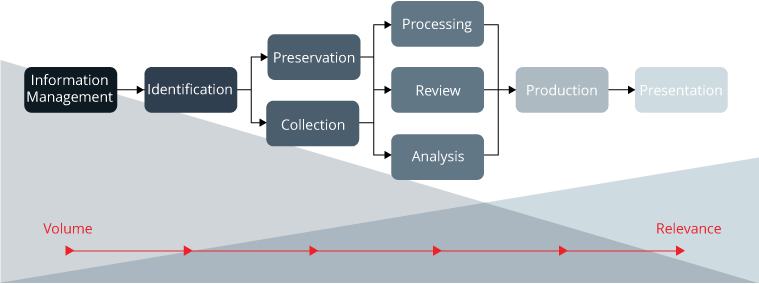How eDiscovery Works
Electronic Discovery Reference Model
- Information ManagementIf your client is diligent in their information governance and retention policies, they will likely have a leg-up at the outset of a matter.
Keeping track of relevant information in the digital space can be a tricky task, but if proper software is put in place, the tracking and retention of information is made simple. A robust records management platform like IST DocStor RIM and case management solution like IST DocStor Legal will allow users to enable retention policies, create hold notices and correspondence from a library of templates, store all correspondence in a single location and integrate with other systems to automatically send alerts and reports to stakeholders. Built-in reporting dashboards are useful to show the status of all legal holds at a glance.
- IdentificationIn today’s technological world, almost every litigation matter potentially involves eDiscovery.
At this point, the custodians or users and the type of relevant documents are identified (email, spreadsheets, voicemail, presentations, databases, documents, etc.) IST Discover-E’s expert Project Managers offer consultative expertise to aid attorneys to assess, at the outset of each case, what electronic discovery issues might arise during the litigation, including the likelihood that e-discovery will or should be sought by either side. Attorneys handling e-discovery should be able to perform (either by themselves or in association with expert consultants) the following: Inventory eDiscovery needs and issues in the matter, Implement appropriate Electronically Stored Information (ESI) preservation procedures, Analyze and understand a client’s ESI systems and storage, Advise the client on available options for collection and preservation of ESI and Identify custodians of potentially relevant ESI.
- PreservationTraditional tracking of legal holds manually with spreadsheets or homegrown databases is unwieldy. Organizations with multiple, ongoing holds discover that this approach fails to scale.
When a lawsuit occurs — or is anticipated to occur — in-house counsel must communicate a legal hold notice (also known as a “litigation hold” notice) to potential custodians of relevant information. The “duty to preserve” electronically stored information (ESI) related to the lawsuit must be clearly and consistently communicated in order to ensure data is not destroyed or altered, either accidentally or deliberately thus avoiding claims of spoliation. Legal hold technologies like those provided by IST Discover-E within Relativity can help ensure consistent, repeatable processes. Workflows, templates, and mobile-friendly custodian portals within relativity help legal and business teams get through the preservation phase of eDiscovery with consistent, auditable processes.
- CollectionIST Discover-E offers experts working with inside and outside counsel since 1998 to control the cost, quality, security and defensibility of identifying and accessing electronically stored information for litigation purposes.
Collects the data so it may be sent to the vendor for processing review and analysis. Methods that will facilitate the transfer of data are FTP (file transfer protocol), hard drives, thumb drives, CD/DVD, data tapes, etc. IST Discover-E provides consultation and guidance in collections and have the ability to travel anywhere in the world to collect data. When onsite, or working remotely, our experienced investigators perform targeted searches and know what questions to ask to find all data needed for the case. They can customize the custodian interview process based on the location of the data and conversation about where the data may live.
- Processing
We capture metadata from the files such as date created, date last modified, text, author, email and attachments, etc. and provide the ability to run filtering such as date filtering, file type filtering, DeNisting, location, and Domain filtering. This gives our clients the ability to run searches and remove data prior to the review. The advantages are as follows: Billed Once for the Culled Data Set (De-Duplication, Date Restriction, Full Text Extraction, Metadata and deNISTing - Domain, Date, File Type and File Location Filtering), All-In & In and Out Pricing Includes Processing, Production and Exports, View data as a map of similar documents, labeled by key search terms using cluster visualization, Can View the Entire Culled and deNisted Data Set, Performing Unlimited Searches
- ReviewIST Discover-E provides the control and flexibility you need to design workflows and solutions that amplify your team’s efforts and get to the real substance of a matter.
Attorneys will now review the documents that have been loaded into IST's on-line tool, Relativity. This tool allows attorneys to analyze, search, filter, categorize, and identify the relevant documents. IST Discover-E provides the hosting platform for review within Relativity Hosted Review for your own attorneys or we can provide attorney staffing and/or review offices to perform the full document review off-site. In addition to providing our clients with experienced contract attorneys, team leaders, and project managers, IST Discover-E can also offer a fully functional, secure facility to host document review. Located in Atlanta, GA the Review Center spans over 2,000 square feet of Class A office space, offering the ideal environment for efficient, cost-effective review of electronically stored information. The Review Center provides a wide range of technology and security features, along with amenities that make the review process both cost-effective and efficient.
- AnalysisThe better your analysis the stronger your case.
This task is performed in conjunction with the processing and review stages to strategically refine and narrow the volume of documents for review. Analytic methodologies may be used for: Reducing data volume, Zeroing in on documents of interest, Understanding what the data contain to assist in the producer’s own strategic decisions, Gauging the productivity of reviewers, Helping in identifying other potential sources of responsive ESI, Documenting what took place during collection and processing. Where eDiscovery Processing is the first step to reducing the volume of Electronically Stored Information (ESI) and 70 percent of e-discovery overhead is associated with Attorney Review, it becomes clear that the better the technology and ability to analyze postprocessed data, the more quickly a firm can drive down costs by reducing the amount of documents necessary for review. Additional Analytics can be applied, based on the need of the case, at an additional cost. These Analytics include: Email Threading, Near Duplication, Predictive Coding, Concept Searching, Clustering, Categorization, Language Identification.
- Production
As part of IST Discover-E’s simplified and predictable pricing models, data productions are provided as part of the service and not an add-on charge. With IST Discover-E you get unlimited post-processed data production including: Tiff and OCR Conversion, Bates Labeling and Branding.
- Presentation
Attorneys will now present the produced documents as evidence to persuade judge or jury for a winning decision in court.




